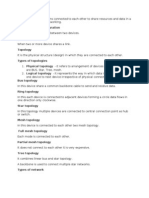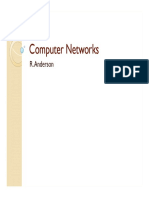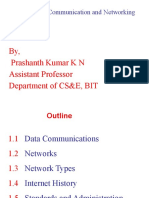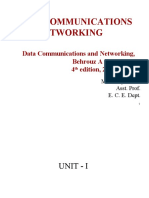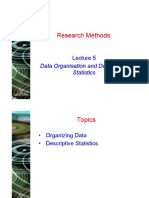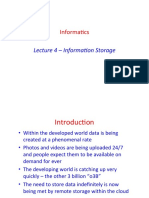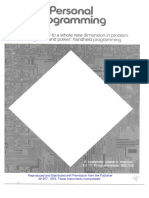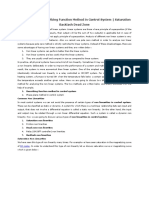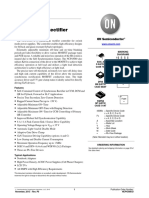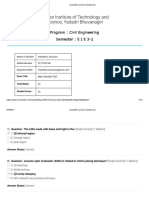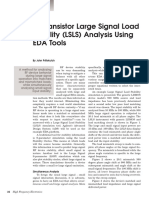Informatics
Lecture 5
Transmission of Information
�Introduction
This module is concerned with the
movement of data from one place to
another
Some figures to keep in mind as we
proceed
1990s internet = 56 kbit/s
2013 office = 10-100 Mbit/s
3G = 200 kbit/s
4G = 100 Mbit/s
�Introduction
In this lecture we will deal with a
number of aspects of communication
networks:
Performance parameters
Types of network
Network topologies
Standards
Protocols
�Introduction
This item list reflects the obvious
issues in even just 2 people trying to
communicate:
What language to use
Who talks
When to answer
What if something is mis-heard
What if something is lost in the
noise
Etc
�Introduction
The study of networks can be a highly
technical subject in terms of both
hardware and software we can
really only just skim the surface
�Performance parameters
Usually this is concerned with how
much information can be transmitted
over a network. We will consider:
Bandwidth
Bit rate
Latency
�Bandwidth
This is the frequency range of the
signals that are used between nodes
and is usually set by the physical
medium.
The bandwidth limits the rate at which
data is transmitted e.g. a light flashing
at 5 Hz (say with two different colours
for 1 and 0) cannot transmit more
than 5 bits per second.
�Bandwidth
Fibre optics = 100s GHz
Copper wires = 100MHz
Telephone = 10s kHz
Wireless = 1-10 GHz
Of course we can have several
parallel channels being used to
increase the overall rate but most
communication nowadays is single
channel (serial)
�Bit rate
This is the overall rate at which data
is transmitted taking into account the
bandwidth and the number of bits
used to encode the information
If n bits are transmitted
simultaneously then the bit rate is
simply
Bit rate = 2 x n x bandwidth
�Bit rate analogue signals
We can also transmit signals using
voltage levels analogue rather than
digital (256 levels for 8 bits)
This is much more susceptible to
noise. A formal analysis gives:
Bit rate = bandwidth x log2(1+(S/N))
S = signal power N = noise power
�Latency
This is simply the time taken for the
transmission and will be a
combination of propagation and
processing times
High latency will usually result in low
bit rates
Think of communicating with the Mars
Rover (20 minutes)
�Types of Network
Networks are often categorised
according to their extent
This can influence the technologies
used in their physical construction
there are maximum lengths advised
for the various types of cable used
�1. Point to Point
A single direct connection between
2 nodes
Very secure
Very inefficient
Limited range
Few examples available outside adhoc setups
�2. Multipoint
Nodes share connections
More efficient usage
Can get congestion
Network intelligence required to
direct traffic
Typical of cable TV
�3. Personal Area Network PAN
Very local
Connecting devices about your
person
Most likely will use Bluetooth
Other wireless types are feasible
Possibly even a personal hub
�4. Local Area Network LAN
Connecting buildings or a small site
such as a campus
Mixture of wired and wireless
Hardware will be required to direct
traffic to the correct location in
some cases
Network management required
�5. Metropolitan Area Network
MAN
Connecting LANs
Possibly a city network
LANs must be able to communicate
and so standards are required
Serious network management
Wired and wireless
�6. Wide Area Network WAN
Connecting WAN and LAN
Connecting cities and countries
Lots of network management
Lots of network intelligence
Could still be quite local in parts
e.g. overseas traffic through one or
two locations
��7. Circuit switching
In this system a connection is
established between 2 nodes for
communication the old style of
telephone exchange
�8. Packet switching
Data is assembled into packets with
delivery information and sent
across shared connections rather
like surface mail
Packets may travel different routes
and so arrive out of sequence or
get lost
Strict protocols and standards are
required
The de facto method for today
�Network topologies
The physical layout of the network
the logical layout may vary according
to how packets are managed
Bus
Ring
Star
Mesh
�1. Bus
Nodes connected to a single
backbone
Each node receives all the traffic
Ethernet
�2. Ring
Nodes in a closed loop
Use of a token creates the logical
equivalent of point to point
IBM Token Ring
�3. Star
Nodes connected to a controlling
hub which directs traffic
�4. Mesh
Interconnected nodes with multiple
point to point connections
Could connect hubs (internet) or be
used in a highly resilient network
(aircraft)
�Topology Issues
A whole host of issues arise with a
number of topologies
What happens if 2 nodes send out
data at the same time
What happens if a data packet isnt
claimed
What happens if one node is
compromised and captures
everything etc.
�Network Standards
It is easy to see that standards are
required so that devices can
communicate and new hardware can
be developed
Standards exist for both the hardware
and the communication protocols and
this has led to a layered approach
In the layered approach different
functions are devolved to different
systems (hardware or software)
�Network Layers
Logical communication is between
layers but is reality data moves down
and up the layers
NODE A
DATA
NODE B
�Network Layers
Again, just think of a few of the
issues:
A must find B
B must be ready
Packets may be lost or corrupted
The connection may be lost
Packets may arrive out of order
A may send the packets too quickly
�Open System Interconnection
OSI Model
This layered model serves as a
framework for protocol development
In this way devices from different
manufacturers can function together
Application
Presentation
Session
Transport
Network
Data Links
Physical
�OSI Model
Application the data to be sent
Presentation encryption and
character set
Session synchronise
Transport prepare packets
Network routing information
Data Links packet assembly for
error recovery
Physical actual transmission
�TCP/IP Protocol Transmission
Control Protocol/Internet Protocol
This is a development of the OSI
model specifically for reliable
dispersed networking i.e. the Internet
Application
Transport
Internet
Network
�TCP/IP
Application = OSI Application,
Presentation and Session layers
Transport = OSI Transport and
implements TCP or UDP protocols
Internet = OSI Network routing
information the IP header
Network = OSI Data Link and
Physical
�Data Packets
As data travels down through the
various layers it gains additional
information in the form of headers
which are then used by the
corresponding layer in the receiving
node
The exact detail of the packets
depends on the protocol being used
(TCP UDP mail ftp etc.)
�Data Packets
DATA
TCP
FRAME
DATA
IP
TCP
DATA
IP
TCP
DATA
Of course this can mean that a lot of
information can be extracted from a
captured packet even if some of the
contents are encrypted
�What else?
We have only considered a very few
aspects of networking other topics
include:
Network management
The hardware switches and hubs
IP addresses (especially v6)
Load balancing
Security



































